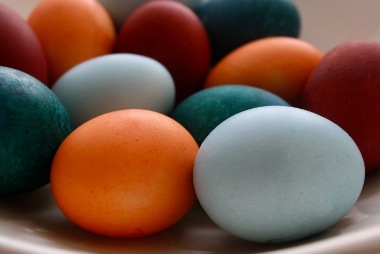 As promised, here’s the vegetarian’s post about how to naturally dye eggs! This was the third year (and third time) I decided to dye the hard boiled eggs traditionally served during the Passover seder. These would also work for Easter or any other spring-related celebration. Or any time you want to eat hard boiled eggs, actually! They’re really fun and brighten up the table, and though they look impressive they’re actually super easy. And, they get easier every time you do it—this year’s egg dying process was much more streamlined and stress-free than that first year.I followed Martha Stewart’s instructions on how to dye the eggs, but basically there’s just a couple steps…
As promised, here’s the vegetarian’s post about how to naturally dye eggs! This was the third year (and third time) I decided to dye the hard boiled eggs traditionally served during the Passover seder. These would also work for Easter or any other spring-related celebration. Or any time you want to eat hard boiled eggs, actually! They’re really fun and brighten up the table, and though they look impressive they’re actually super easy. And, they get easier every time you do it—this year’s egg dying process was much more streamlined and stress-free than that first year.I followed Martha Stewart’s instructions on how to dye the eggs, but basically there’s just a couple steps…
1. Choosing your colors/ingredients: depending on your method of dying the eggs (see step 3), each ingredient yields more than 1 color. Here’s what I made this year:
a. Yellow Onion Skins (~12 onions): red and orange
b. Red Cabbage (~4 cups chopped): bright and light blues
c. Turmeric (~3 tablespoons): bright and light yellows
2. Making the dye: Combine one of the dying “agents” mentioned above with 1 quart of water and 2 tablespoons of white vinegar. Bring to a boil, then simmer for 30 minutes. Strain the ingredient out, leaving just the dye. I think this works best by pouring the dye into a colander on top of another pot. I’ve never figured out how to strain turmeric though…
3. Dying the eggs there are 2 methods.
a. Hot: to make dense, saturated colors, boil raw eggs in the strained dye for 30 minutes, or until it’s a color you like
i. Red: boil in onion skin dye
ii. Bright Yellow: boil in the turmeric dye
b. Cold: to make translucent, lighter colors—or to use cabbage dye, which requires more time to color the eggs—soak already-hard-boiled eggs in dye for 30 minutes, or as designated below
i. Orange: soak in onion skin dye
ii. Bright Blue: soak in cabbage dye overnight (this is the exception to the hot=saturated color rule—it takes a long time for this gorgeous blue to show up, but it’s worth it!)
iii. Light Blue: soak in cabbage dye, or until it’s a color you like. Cabbage dye takes longer to show up!
iv. Light Yellow: soak in turmeric dye
For both dying methods, be sure to rotate the eggs periodically, otherwise you’ll get a little white spot on the egg’s “bottom” from where it was sitting in the pot
I have in the past also made beet dye (which makes pink and lavender, though for lavender you “double dip” in beet and cabbage dye), and made chartreuse eggs (by double dipping eggs in turmeric and cabbage dyes), but I didn’t do that again this year because it was more trouble than I thought it was worth—the blues, red/orange, and yellow eggs are prettier, in my opinion. Martha also gives a recipe for coffee dye that turns eggs brown, but I’ve never tried that—they sell naturally brown eggs! I’ve read there are other ingredients that create dyes, like blueberries, but I’ve yet to try… readers, have any other ingredient suggestions?

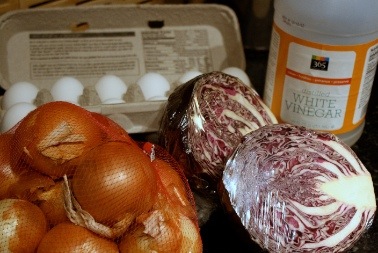
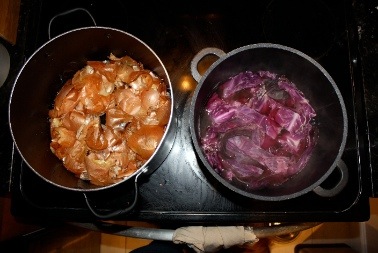
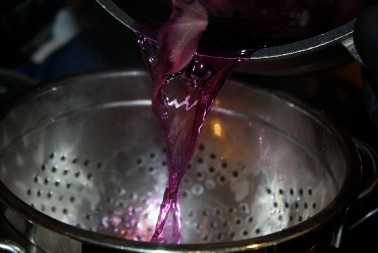
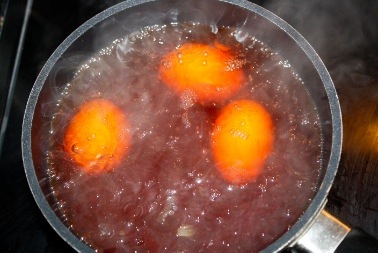
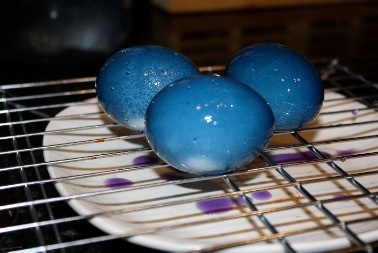







I always wondered how to do these naturally; and now I know thanks to you. Thank you so much for sharing. They look wonderful.
Thanks!! I love making them–they make me feel like the "hostess with the mostess" 🙂
you funny!herb 1419
How very cool!
Pingback: Easter Table « limeinthecoconuts